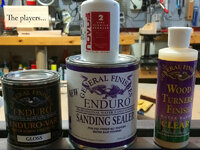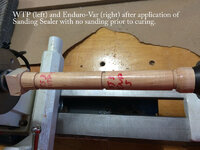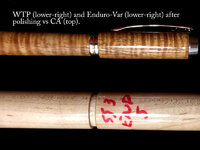Shibumik
Member
General Wood Turner's Finish vs. General Enduro-Var...
I, like many others out there, have been looking for an alternative to CA finishing. While I appreciate the look and feel of natural wood, many woods like burls do not hold up well to active and dirty hands, and people who purchase pens have very different ideas about the beauty and value of shine. To satisfy their needs, I began finishing with CA to develop the lustrous shine they expect. Like many of you, I don't enjoy working with CA, it's nasty and inconvenient stuff. However, its properties of being fast drying and durability are pretty difficult to beat.
So, my challenge was to discover a finishing process that could usurp my CA workflow. Having been familiar and a great fan of the former Water-Borne Finishes in California, I was pleased to hear they had been purchased by General Finishes. After years of working with water-based finishes, I have come to love their properties. They are different because they are colorless, which does take some getting used to. However, they are simple to work with and, once dried, their toughness and ability to withstand some pretty nasty stuff is difficult to beat. I determined it was logical for me to explore a water-based workflow. My two weapons of curiosity are General's Wood Turner's Finish and General's Endur-Var water-based urethane.
What I was looking for…
My goals were to discover a new finish protocol, understand the nature of the finishes and the steps required for a successful finished product.
Questions I needed answered:
1. Ease of application
2. Appearance of finish at application, finishing process and final preparation points
3. Sanding ease and technique
4. Workability of the finish
5. Final look of finish
6. Is the finish a CA replacement?
Preparation...
I turned a piece of hard maple to test the two finishes side by side. I parted the respective test areas and labelled each with a red Sharpie; WTF for Wood Turner's Finish and END for Enduro-Var. The raw wood was sanded to 1000 grit. The wood's temperature was 68 degrees F. at the time of testing.
Each segment was sealed using General's water-based Sanding Sealer using 5 coats applied by a Bounty pad allowing each coat to dry to the touch before adding another. Once dried for about an hour, the segments were sanded with 400 grit automotive dry sandpaper.
The Finish…
I applied 15 coats of Wood Turner's Finish to one side because of its thinner viscosity, and 10 coats of Enduro-Var to the other segment due to its higher viscosity. Each coat was applied using an absorbent Bounty paper pad doubled over to the respective sides.
Each side had finish applied while turning on the lathe at about 1800 RPM. I waited until the finish was dry to the touch before the next coat was applied. The Wood Turner's Finish routinely dried within 60 seconds of application, while the Enduro-Var sometimes required up to 2 minutes between coats. Once the finish layers were complete, the test piece was removed to a 73-degree house environment for a period of 24 hours to cure.
Answering the questions…
Ease of application – Both finishes were extremely simple to apply. The WTF dried to a more satin-like finish and generally required less working than the EV. That said; it was also extremely fragile until fully cured, and was far more fragile and more permeable by water than the EV after Curing. Due to its increased viscosity and shininess, the EV proved to be a rougher finish prior to and after cure, but was dramatically more workable than WTF.
Workability – Here is where it gets interesting. The WTF is extremely workable due to its relative softness, which can lead easily to over working. In other words, it's easy to sand completely off, even after curing. The EV, on the other hand, was more difficult to work, but quite workable. Naturally, this is an indicator of how each will hold its final finish – sort of.
Appearance of finish at various stages of application – Throughout the application phase, WTF appeared to have more of a satin finish than the EV , which remained clear and highly specular. Cloudiness was never noted in either sample. After the 24-hour curing period, the WTF and EV maintained their prior appearances with no visible cloudiness.
Sanding testing – I tested both dry and wet sanding techniques. The WTF readily absorbed water even after curing in my experiments. I recommend dry sanding for the WTF. On the other hand, the EV in uncured and cures states held up well to even aggressive sanding and benefitted from wet sanding more than dry. I recommend wet sanding for EV finishes on pens. All finish sanding started at 1000 grit and ended at 12,000 grit using Micro-Mesh pads.
How workable was the finish?– As indicated above, my weapon of choice was Micro-Mesh 1k-12k grits. I finalized the finish using Novus #2 scratch remover. At the end of this process, the WTF had a poor-looking appearance likely unsuitable for most pens. The EV displayed a spectacular finish at this point along with impact resistance clearly superior to WTF.
Final look of finish - As a final finish, each piece was buffed on a Beall buffing system with fine and ultra-fine compounds acquired from Caswell. This brought the ETF to life - or at least back from the dead. While noticeably thinner than the EV, the WTF exhibited a beautiful finish what would likely benefit from Carnauba wax or other surface protectant. When the EV was buffed, the buffing tended to flatten the finish surface and polish it to a higher higher sheen. The end result was a more "plasticy" finish appearance virtually indistinguishable from CA.
Are these finishes CA replacements? - Yes and no. The WTF, when buffed, displays a very nice finish although I question its ultimate durability over time. The EV finish is spectacular and certainly one to consider for a CA replacement.
Final observations…
The General Finishes products are both excellent, each having its own benefits and constraints when it comes to pen construction. When compared to traditional CA approaches, the General water-based finishes do require greater drying time, but the overall working time of each is so similar they are indistinguishable. While I cannot recommend WTF without further testing due to its lack of robustness in my tests, General's Enduro-Var water-based urethane is a clear winner for pen makers and more than worthy of your consideration for a viable CA replacement in your finishing workflow.
I, like many others out there, have been looking for an alternative to CA finishing. While I appreciate the look and feel of natural wood, many woods like burls do not hold up well to active and dirty hands, and people who purchase pens have very different ideas about the beauty and value of shine. To satisfy their needs, I began finishing with CA to develop the lustrous shine they expect. Like many of you, I don't enjoy working with CA, it's nasty and inconvenient stuff. However, its properties of being fast drying and durability are pretty difficult to beat.
So, my challenge was to discover a finishing process that could usurp my CA workflow. Having been familiar and a great fan of the former Water-Borne Finishes in California, I was pleased to hear they had been purchased by General Finishes. After years of working with water-based finishes, I have come to love their properties. They are different because they are colorless, which does take some getting used to. However, they are simple to work with and, once dried, their toughness and ability to withstand some pretty nasty stuff is difficult to beat. I determined it was logical for me to explore a water-based workflow. My two weapons of curiosity are General's Wood Turner's Finish and General's Endur-Var water-based urethane.
What I was looking for…
My goals were to discover a new finish protocol, understand the nature of the finishes and the steps required for a successful finished product.
Questions I needed answered:
1. Ease of application
2. Appearance of finish at application, finishing process and final preparation points
3. Sanding ease and technique
4. Workability of the finish
5. Final look of finish
6. Is the finish a CA replacement?
Preparation...
I turned a piece of hard maple to test the two finishes side by side. I parted the respective test areas and labelled each with a red Sharpie; WTF for Wood Turner's Finish and END for Enduro-Var. The raw wood was sanded to 1000 grit. The wood's temperature was 68 degrees F. at the time of testing.
Each segment was sealed using General's water-based Sanding Sealer using 5 coats applied by a Bounty pad allowing each coat to dry to the touch before adding another. Once dried for about an hour, the segments were sanded with 400 grit automotive dry sandpaper.
The Finish…
I applied 15 coats of Wood Turner's Finish to one side because of its thinner viscosity, and 10 coats of Enduro-Var to the other segment due to its higher viscosity. Each coat was applied using an absorbent Bounty paper pad doubled over to the respective sides.
Each side had finish applied while turning on the lathe at about 1800 RPM. I waited until the finish was dry to the touch before the next coat was applied. The Wood Turner's Finish routinely dried within 60 seconds of application, while the Enduro-Var sometimes required up to 2 minutes between coats. Once the finish layers were complete, the test piece was removed to a 73-degree house environment for a period of 24 hours to cure.
Answering the questions…
Ease of application – Both finishes were extremely simple to apply. The WTF dried to a more satin-like finish and generally required less working than the EV. That said; it was also extremely fragile until fully cured, and was far more fragile and more permeable by water than the EV after Curing. Due to its increased viscosity and shininess, the EV proved to be a rougher finish prior to and after cure, but was dramatically more workable than WTF.
Workability – Here is where it gets interesting. The WTF is extremely workable due to its relative softness, which can lead easily to over working. In other words, it's easy to sand completely off, even after curing. The EV, on the other hand, was more difficult to work, but quite workable. Naturally, this is an indicator of how each will hold its final finish – sort of.
Appearance of finish at various stages of application – Throughout the application phase, WTF appeared to have more of a satin finish than the EV , which remained clear and highly specular. Cloudiness was never noted in either sample. After the 24-hour curing period, the WTF and EV maintained their prior appearances with no visible cloudiness.
Sanding testing – I tested both dry and wet sanding techniques. The WTF readily absorbed water even after curing in my experiments. I recommend dry sanding for the WTF. On the other hand, the EV in uncured and cures states held up well to even aggressive sanding and benefitted from wet sanding more than dry. I recommend wet sanding for EV finishes on pens. All finish sanding started at 1000 grit and ended at 12,000 grit using Micro-Mesh pads.
How workable was the finish?– As indicated above, my weapon of choice was Micro-Mesh 1k-12k grits. I finalized the finish using Novus #2 scratch remover. At the end of this process, the WTF had a poor-looking appearance likely unsuitable for most pens. The EV displayed a spectacular finish at this point along with impact resistance clearly superior to WTF.
Final look of finish - As a final finish, each piece was buffed on a Beall buffing system with fine and ultra-fine compounds acquired from Caswell. This brought the ETF to life - or at least back from the dead. While noticeably thinner than the EV, the WTF exhibited a beautiful finish what would likely benefit from Carnauba wax or other surface protectant. When the EV was buffed, the buffing tended to flatten the finish surface and polish it to a higher higher sheen. The end result was a more "plasticy" finish appearance virtually indistinguishable from CA.
Are these finishes CA replacements? - Yes and no. The WTF, when buffed, displays a very nice finish although I question its ultimate durability over time. The EV finish is spectacular and certainly one to consider for a CA replacement.
Final observations…
The General Finishes products are both excellent, each having its own benefits and constraints when it comes to pen construction. When compared to traditional CA approaches, the General water-based finishes do require greater drying time, but the overall working time of each is so similar they are indistinguishable. While I cannot recommend WTF without further testing due to its lack of robustness in my tests, General's Enduro-Var water-based urethane is a clear winner for pen makers and more than worthy of your consideration for a viable CA replacement in your finishing workflow.
Attachments
Last edited:



